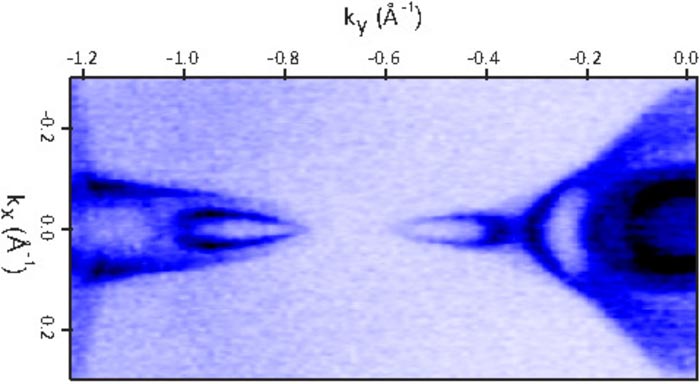Fermi Arcs in an Antiferromagnet detected at BESSY II

Fermi surface of antiferromagnetic NdBi taken at 6 K temperature at BESSY II. It shows so called Fermi arcs.
Credit: https://www.nature.com/articles/s41586-022-04412-x
Neodymium-Bismuth crystals belong to the wide range of materials with interesting magnetic properties. The Fermi surface which is measured in the experiments contains information on the transport properties of charge carriers in the crystal.
While usually the Fermi surface consists of closed contours, disconnected sections known as Fermi arcs are very rare and can be signatures of unusual electronic states.
Unusual magnetic splittings
In a study, published now in Nature, the team presents experimental evidence for such Fermi arcs. They observed an unusual magnetic splitting in the antiferromagnetic state of the samples below a temperature of 24 Kelvin (the Néel-temperature).
This splitting creates bands of opposing curvature, which changes with temperature together with the antiferromagnetic order.
These findings are very important because they are fundamentally different from previously theoretically considered and experimentally reported cases of magnetic splittings. In the case of well-known Zeeman and Rashba splittings, the curvature of the bands is always preserved.
Since both splittings are important for spintronics, these new findings could lead to novel applications, especially as the focus of spintronics research is currently moving from traditional ferromagnetic to antiferromagnetic materials.
Journal: Nature
DOI: 10.1038/s41586-022-04412-x
Method of Research: Experimental study
Subject of Research: Not applicable
Article Title: Emergence of Fermi arcs due to magnetic splitting in an antiferromagnet
Article Publication Date: 23-Mar-2022
COI Statement: none
https://www.helmholtz-berlin.de/pubbin/news_seite?nid=23507&sprache=en&seitenid=1
All latest news from the category: Physics and Astronomy
This area deals with the fundamental laws and building blocks of nature and how they interact, the properties and the behavior of matter, and research into space and time and their structures.
innovations-report provides in-depth reports and articles on subjects such as astrophysics, laser technologies, nuclear, quantum, particle and solid-state physics, nanotechnologies, planetary research and findings (Mars, Venus) and developments related to the Hubble Telescope.
Newest articles

NASA: Mystery of life’s handedness deepens
The mystery of why life uses molecules with specific orientations has deepened with a NASA-funded discovery that RNA — a key molecule thought to have potentially held the instructions for…

What are the effects of historic lithium mining on water quality?
Study reveals low levels of common contaminants but high levels of other elements in waters associated with an abandoned lithium mine. Lithium ore and mining waste from a historic lithium…

Quantum-inspired design boosts efficiency of heat-to-electricity conversion
Rice engineers take unconventional route to improving thermophotovoltaic systems. Researchers at Rice University have found a new way to improve a key element of thermophotovoltaic (TPV) systems, which convert heat…



